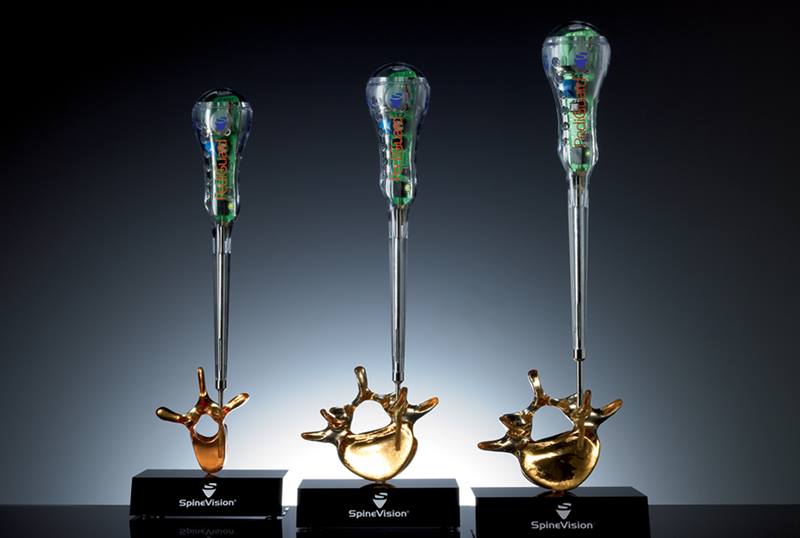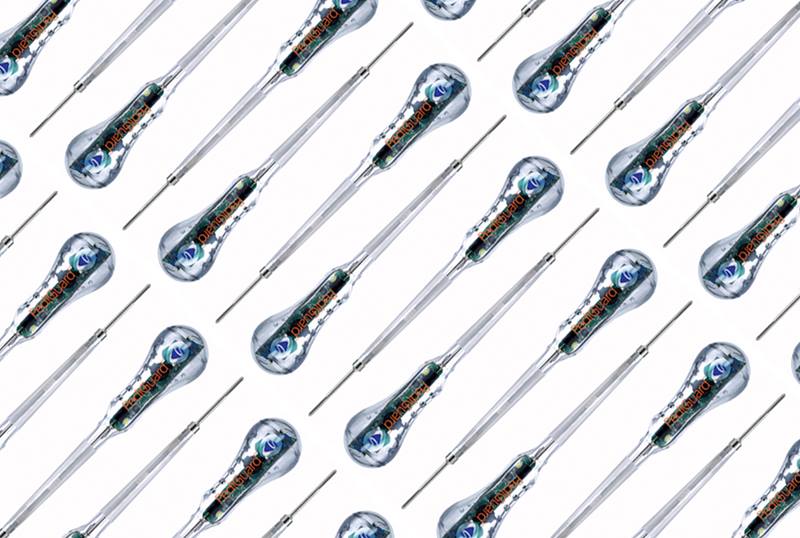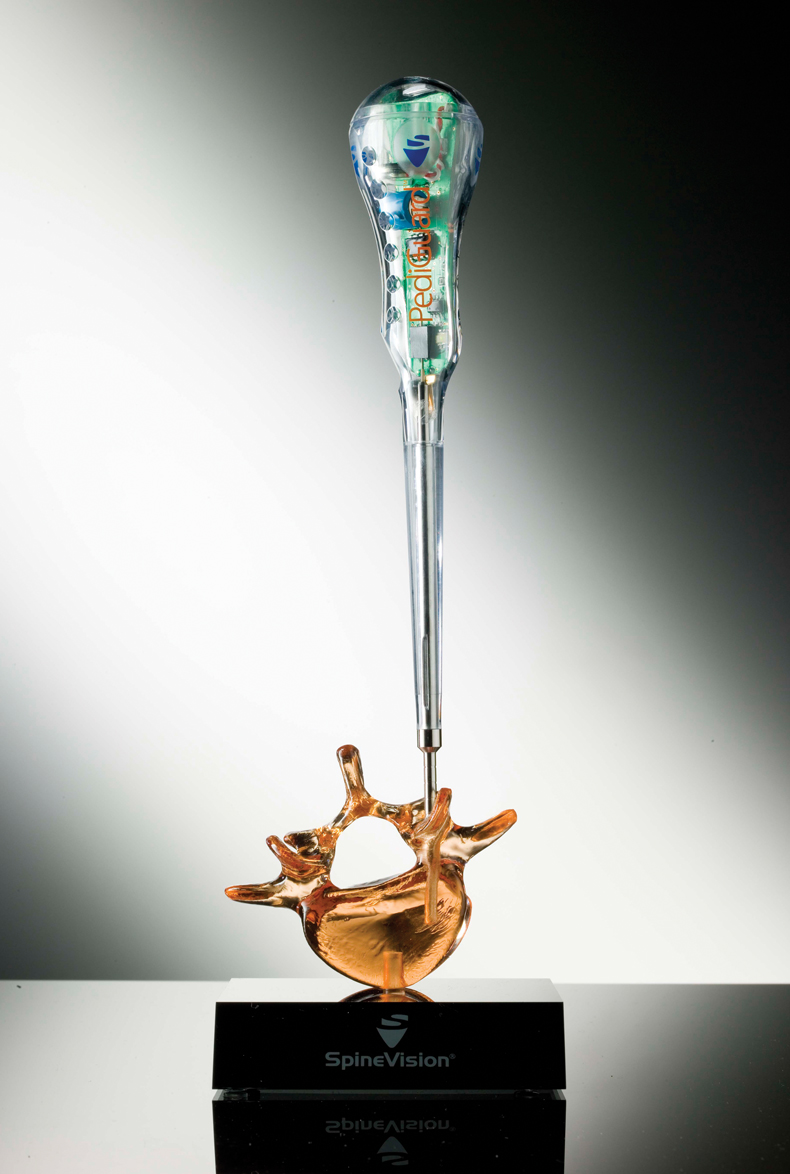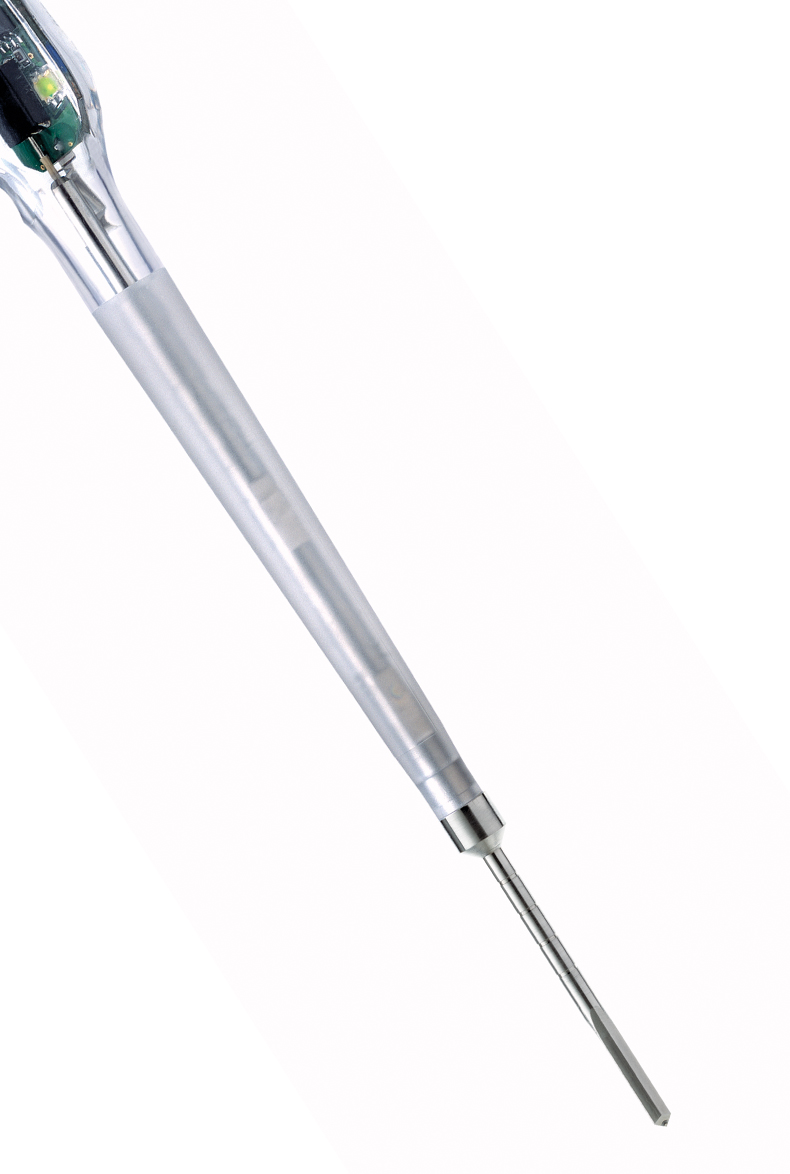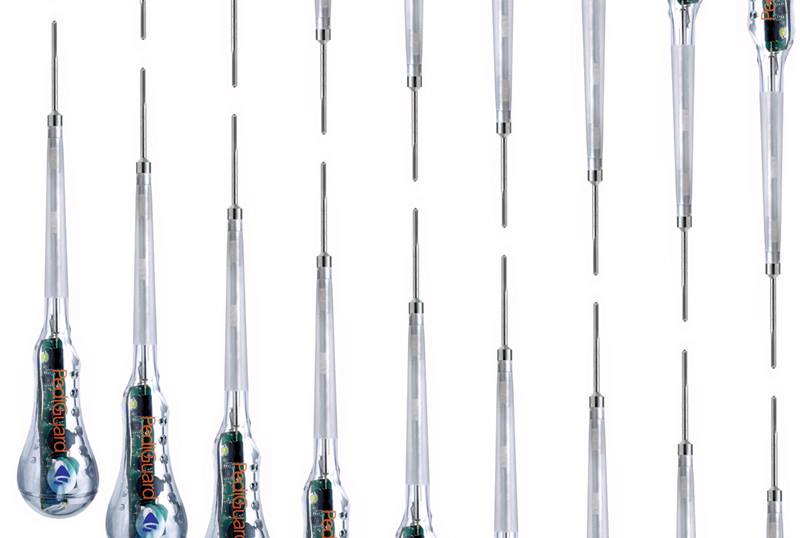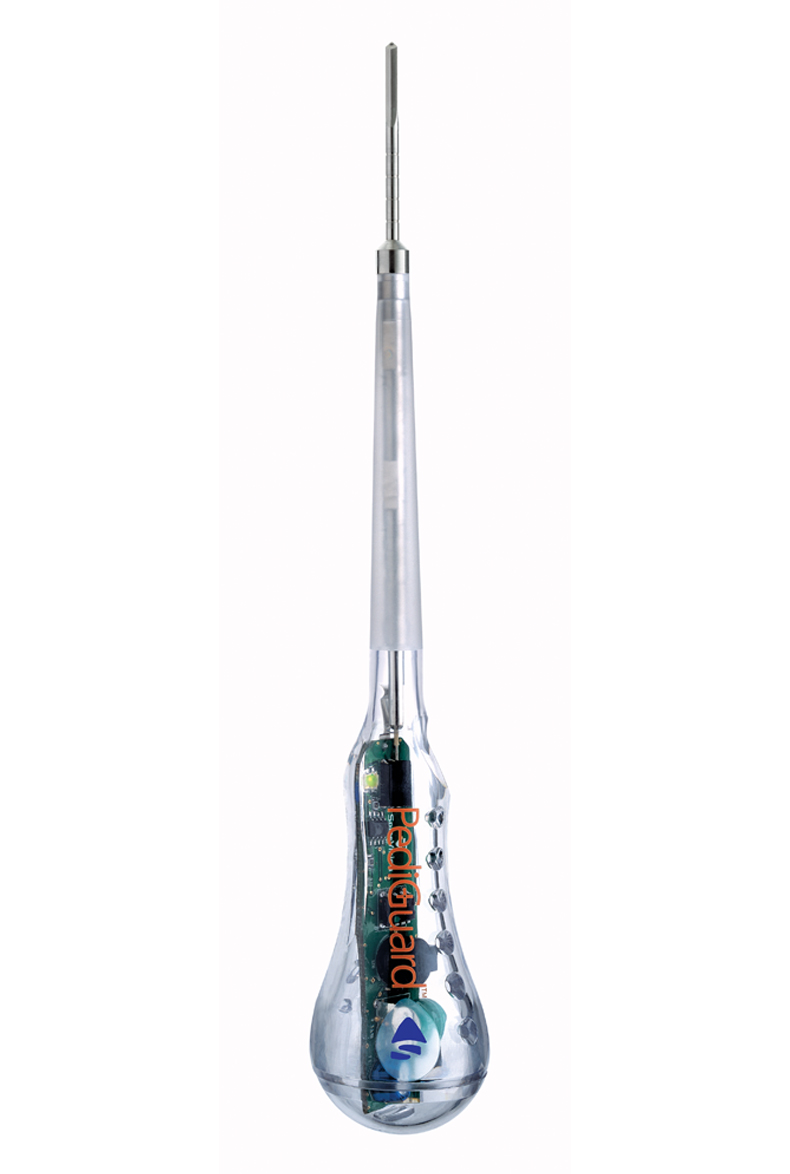* DESIGN OF
THE YEAR 2007

Pediguard
SpineVision’s PediGuard™
Back pain is very common – about three in four adults experience back pain during their lifetime – and this may be caused by deformities, lumbar degenerative disc diseases, cervical disorders, trauma and tumors, some cases requiring surgery. Scoliosis for example is a condition that involves complex lateral and rotational curvature of the spine. Spine surgery is performed to stop the scoliosis from progressing, restore the spine to a more normal alignment and appearance, and to address any back pain, heart or lung function problems caused by the scoliosis.
Spinal fusion is the most common surgical procedure (about one million performed worldwide annually). Implants such as screws and rods are used to help the spine fuse. Placement of screws in the vertebra is challenging: surgeons must carefully prepare a pilot hole using a perforation instrument to ensure that the screw is placed within the pedicle. Perforating the vertebral pedicle wall is a common complication related to pedicle screw insertion, and may result in very serious clinical consequences. Published rates of intra-operatively ‘misplaced’ pedicle screws range from 10 to 40 percent.
There have been attempts to introduce navigational aids to surgeons, involving expensive and elaborate 3-D scanning of the spinal column but these require pre-operative scans, continuous scanning during the operation and important exposure to X-rays, the most common scanning method used.
PediGuard™ is the first patented, wireless, electronic handheld instrument capable of accurately detecting changes in tissue type, and providing audio and visual feedback to surgeons as to whether the tip is in contact with cortical bone, cancellous bone, soft tissues or blood, allowing safe navigation throughout the drilling process.
PediGuard™ is rapidly becoming a standard of care for many surgeons when they are performing pedicle screw fixation. The innovative design allows the surgeon to remain in control at all times during drilling and unlike traditional scanning methods there is no requirement for scanning the patient before or during the operation, which reduces exposure of the patient and medical staff to X-rays.
PediGuard™ has a unique, first-of-its-kind design that warrants merit for its outstanding contribution to the neurosurgeon, orthopedic surgeon, and the thousands of patients worldwide that have already benefitted from its accuracy and precision.
SpineVision and PSB Technologies
PediGuard™ is owned by SpineVision, an integrated spinal technology company focused on the design and commercialisation of innovative implants and instrumentation that offer key advantages to surgeons and benefits to patients. Founded in 1999, SpineVision continually develops new innovative products, especially in the area of motion preservation and minimally invasive surgery. SpineVision is headquartered in Paris, France, and has subsidiaries in Belgium, Italy, Singapore, UK and the USA.
PSB Technologies has further refined the product to transform the original PediGuard™ prototype into a single-use sterile device. The design work done by PSB Technologies includes electronics, software, industrial and mechanical design. Prototypes were fabricated in-house while mass production was carried out by Beyonics Technology Ltd in Singapore.
For more than 20 years, PSB Technologies has established an unrivalled track record in providing global companies innovative, efficient and viable manufacturing solutions for their businesses. Their Product Design and Engineering Centre (PDE) was founded in 1987 to focus on several key areas in manufacturing such as Factory Automation and System Integration, Product Design and Engineering, Environmental Engineering (waste heat recovery and waste water treatment) Consultancy and corporate training in occupational health and safety.
With their diverse team of experts, PSB Technologies is committed to forging strong ties with R&D centres and manufacturers. Operating as a one-stop design centre, they provide industrial, mechanical, electronic hardware and software design services and assist clients in prototyping and low volume production. PSB Technologies has garnered many prestigious awards such as the Red Dot Design Award, Worldstar Packaging Award, Singapore Design Award and the Good Design Award (Japan).
READ MORE
ABOUT THE DESIGNER
READ MORECOMPANY
PSB Technologies Pte Ltd
DESIGN
Ulrich Schraudolph, Design Director
ELECTRONIC SOFTWARE
Koh Soon Wee, Senior Engineer
MANUFACTURER
SpineVision
DESIGN TEAM
Lead Designer & Industrial/Mechanical
ELECTRONIC HARDWARE
Wu Zhu Lai, Senior Engineer
PROTOTYPING
Ang Hock Leong, Steven, Engineer
Insights from the Recipient
Citation
Jury Citation
PediGuard ™ is an outstanding example of rigorous problem analysis, human-centred innovation, ingenious use of materials and technology, and design entrepreneurship. It is a smart hand drill for spinal surgery that addresses a very specific, life-critical medical need that is wide-spread.
Back ailment is the most common universal medical condition and there are more than one million spinal surgeries performed annually. Amongst various other frequent medical procedures, spinal surgery has one of the highest failure rates.
One of the most delicate aspects of this procedure is the accurate placement of titanium or stainless steel screws, called pedicles, into the spinal bone to reinforce the vertebrae while the spinal fusion heals. Accurate placement depends greatly on a surgeon’s skill, which sometimes is supplemented by costly 3-D imaging. Forty percent of the time, screws are misplaced and end up going into soft tissue or nerve tissue.
By electronically sensing tissue density, PediGuard ™ guides the surgeon in correctly drilling a pilot hole for the screw. The drill gives an audible signal and visual LED feedback to guide the surgeon into solid bone and away from soft tissue and nerve tissue.
PediGuard ™ is only licensed to surgeons who are required to fulfill a thorough training certification program. The drill ends are disposable, while the clip-out electronics unit can be used repeatedly.
VIEW JURORSNominator Citation
MAURICE BOURLION
FORMER EXECUTIVE VP
PEDIGUARD™ DIVISION SPINEVISION
PROFESSOR AT JEAN MONNET UNIVERSITY SAINT-ETIENNE, FRANCE
It is with great pleasure that I nominate PediGuard™ for the President’s Design Award 2007 ‘Designs of the Year’ category to recognise the outstanding contribution of the nation’s design talents. In order to best understand the significance of PediGuard™’s designs, it is important to first provide background on back pain, current corrective procedures and challenges.
Back pain is very common – about three in four adults experience back pain during their lifetime, and some cases require surgery because spine disks are deteriorated. Scoliosis is a condition that involves complex lateral and rotational curvature and deformity of the spine. Spine surgery is performed to stop the scoliosis from progressing, restore the spine to a more normal alignment and appearance, and to address any back pain or heart or lung function problems caused by the scoliosis. Spinal fusion is the most common surgical procedure, totaling about one million per year in the world, and uses implants such as screws and rods to help the spine fuse. Placement of screws in the vertebra is challenging; surgeons must carefully prepare a pilot hole using a perforation instrument to ensure the screw is placed within the pedicle. Perforating the vertebral pedicle wall is a common complication related to pedicle screw insertion, and very serious clinical consequences may result. Published rates of intra-operatively ‘misplaced’ pedicle screws range from 10 to 40 percent, resulting in poor anchorage of the construct and some of which result in pathological consequences such as spinal cord damage, including paraplegia or quadriplegia which are irreversible disasters.
PediGuard™ is the first patented, wireless, handheld instrument capable of accurately detecting changes in tissue type, thus alerting surgeons to potential pedicular or vertebral breaches during pedicle screw site preparation. It monitors the electrical conductivity of the tissue at its tip throughout the drilling process. By translating the measured conductivity into an audio and visual feedback, PediGuard™ helps surgeons to discriminate whether the tip is in contact with the cortical bone, cancellous bone or soft tissues.
PediGuard™ has rapidly become a standard of care for many surgeons worldwide when they are performing pedicle screw fixation and has been used successfully on several thousands of patients. The technology that makes the PediGuard™ unique is very straight-forward and the time required to feel confident in using PediGuard™ as a navigational tool for the pedicle preparation is short. The innovative design allows the surgeon to remain in control at all times during drilling and unlike traditional methods, here is no requirement for pre-operative scans for navigational aids or continuous screening when advancing into the pedicle. Reducing the required amount of X-rays is both beneficial to the patient and the operating room staff.
PediGuard™ is a unique, ‘first-of-its-kind’ design that warrants merit for its outstanding contribution to the neurosurgeon, orthopedic surgeon, and thousands of patients that have benefited from its accuracy and precision.
